Uncategorized
Wig Density Explained: What It Is and How to Choose the Right One?
Wig density is key to creating a flawless, natural-looking wig. But what exactly is wig density, and how do you choose the right one? In this detailed guide, we’ll explore the concept of wig density, help you understand how to find the perfect density for your needs, and discuss the factors that play a role in making this important decision.
1. What is wig density?
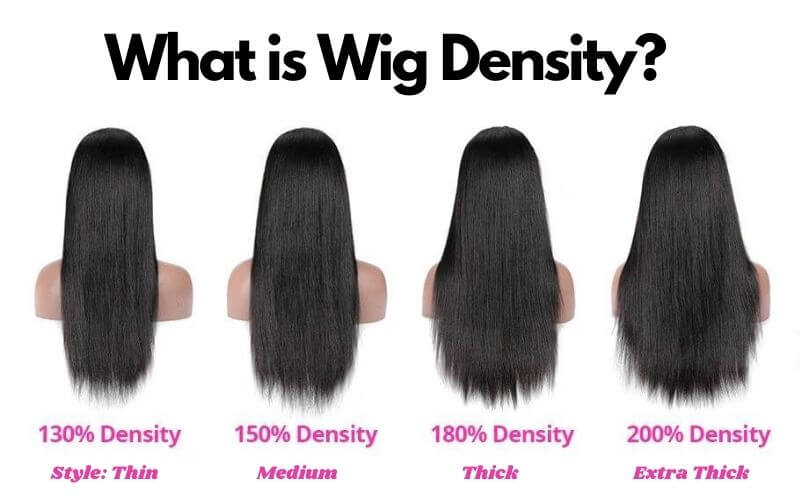
What does density mean in wigs? Wig density refers to how much hair is added to the wig cap. In simple terms, it measures how thick and full the wig looks. Just like natural hair can be thin or thick, wigs also come in different density levels.
Density is usually shown as a percentage — for example, 120% density is considered medium and gives a natural look, similar to the average human head. The higher the percentage, the fuller and more voluminous the wig will appear. Lower percentages mean the wig will look lighter and more natural, while higher ones give a thicker, more glamorous style.
It’s important to know that density is about how much hair is on the wig, not how thick each strand is. You can have a wig with fine strands but high density, and vice versa.
Wig density not only affects the appearance but also the weight and feel of the wig. So choosing the right density helps you get the look and comfort you want — whether that’s sleek and natural or bold and voluminous.
2. Why Is Wig Density Important?
If you’ve ever doubted the significance of wig density, it’s time for a revelation – it matters, and it matters a lot!
Opting for a wig with a density that mirrors your natural hair ensures that your secret remains well-hidden, and observers see only your fabulous locks. Moreover, it ensures a comfortable fit without causing any discomfort or harm to your scalp.
Let’s delve into four compelling reasons why you should give due consideration to hair density when embarking on your wig-buying journey.
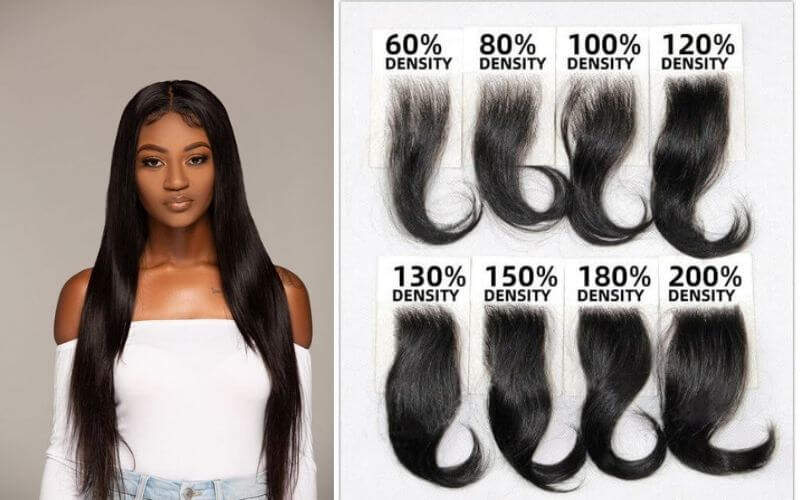
2.1. It Shapes Your Look
The density of your wig directly affects the final style. Want a full, glamorous look? Go for a higher density like 150%–200%. Prefer something lightweight and natural? A density of 120% or less will feel and look more like your own hair. The right density helps you achieve the style you want — from sleek to voluminous.
2.2. It Affects Styling Options
More density gives you more hair to play with — ideal for updos, curls, or layered styles. Lower density wigs are better for simple, everyday wear. Choosing the right density gives you freedom to create the hairstyles you love.
2.3. It Impacts Maintenance
Higher-density wigs have more hair, which means more care — they may need more moisturizing and gentle handling to prevent tangling. Lower-density wigs are lighter and easier to maintain but may not last as long with frequent styling. Knowing your wig’s density helps you care for it properly.
>> READ MORE: Vietnamese Hair Wigs – Top 5 best wig vendors
2.4. It Influences Comfort
Wigs with very high density can feel heavier and warmer, especially in hot weather. Lighter-density wigs are more breathable and comfortable for all-day wear.
2.5. It Affects Price
The more hair a wig has, the more it costs. Higher-density wigs use more hair and take more time to make. If you’re working with a budget, you might choose a lighter density — and still get a beautiful, natural look.
3. How Wig Density is Categorized?
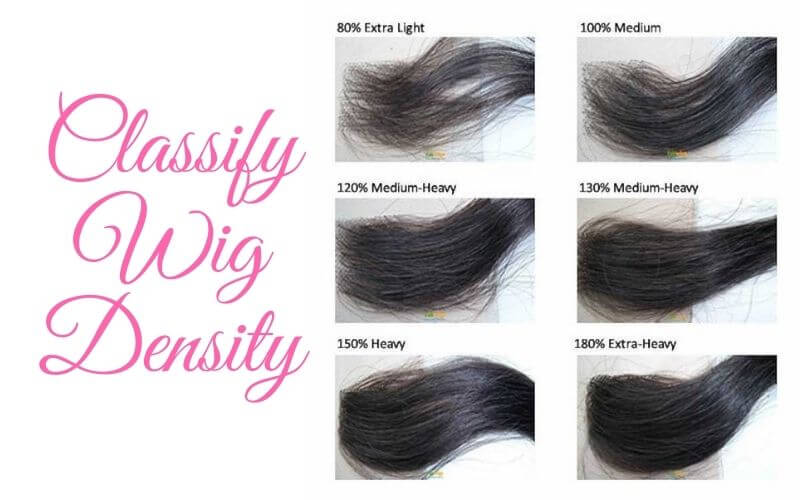
Wig density is commonly categorized through percentages or descriptive terms that convey the wig’s thickness or fullness. Percentage classification represents the amount of hair on the wig cap relative to the average human head, including categories like Extra low density, Low density, Medium Density and High…. Alternatively, term classification uses descriptive terms like Natural, indicating a density close to the average human head (around 100% to 120%), or Full for wigs with higher density (around 150% to 180%). Thin or Light describes wigs with lower density, typically around 60% to 80%. These classification methods provide wig buyers with a clear way to choose a density that suits their desired look, style, comfort, and maintenance preferences.
4. Wig Density Chart
Wig densities come in a range of options to cater to diverse preferences and requirements. Here’s an overview of different wig density levels and their characteristics:
4.1. Extra low density wigs: 50% to 60%
These wigs feature the sparsest concentration of hair, making them ideal for achieving extremely natural-looking hairlines. They are suitable for individuals with very fine or thin hair, offering a subtle and realistic appearance.
4.2. Low density wigs : 80% – 90%
Low-density wigs are lightweight and natural in appearance. Wig has density from 80% to 90% is considered a low density wig. They provide a delicate, subtle look that’s comfortable for everyday wear and are often used to create a seamless hairline.
4.3. Low to Medium Density: 100% – 110%
This density level offers a natural feel and appearance. Light at the hairline, it gradually transitions to medium density for a balanced, realistic look that closely resembles natural hair.
>> READ MORE: https://lynhair.com/best-glueless-wigs/
4.4. Medium Density: 120% to 130%
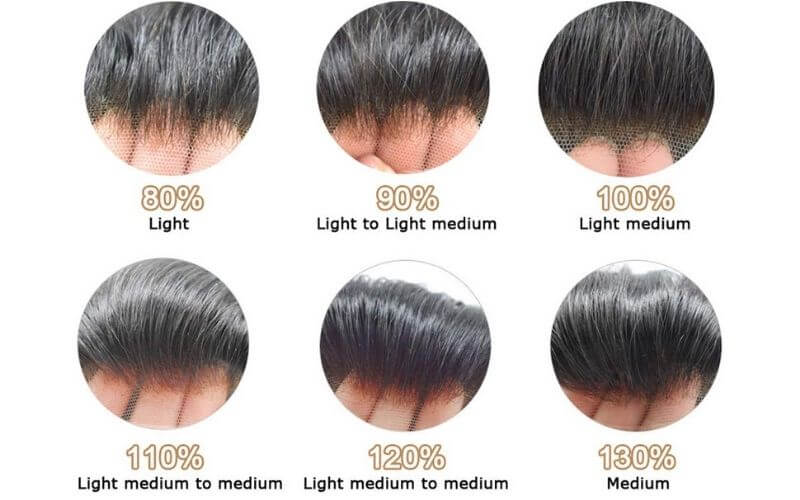
Medium-density wigs mimic the regular hair density found on an average human head. They provide a natural fullness that is neither too thick nor too thin, making them a popular choice.
4.5. High density wigs: 140% to 150%
These wigs offer a fuller and more voluminous look compared to medium density. They are slightly heavier and provide versatility with bounce, movement, and various styling options.
4.6. Extra High Density Wigs: 160%, 180% and 200 density wig
Reserved for special occasions or performances, these wigs are the heaviest and offer unique styling possibilities. They provide a dramatic and high-volume look, although they may be less comfortable for extended wear due to their weight.
5. How to choose density for a wig ?
Choosing the right wig density involves taking various factors into account to ensure it aligns with your preferences and lifestyle.

5.1. Consider Your Natural Hair
If you want your wig to blend with your natural hair, match the wig density to your own hair thickness. Light to medium-density wigs are ideal for fine or thin hair, while medium to heavy density works better for thicker hair.
5.2. Think About Your Lifestyle
If you’re active or live in a hot climate, lighter-density wigs (100%-120%) will be more breathable and comfortable. For special occasions or trying out various styles, a medium to high-density wig (150%-180%) is better.
5.3. Face Shape
Lighter-density wigs are great for smaller faces, as they won’t overwhelm your features. Medium to heavy-density wigs (150%-200%) work better for round or square faces, adding volume and balance.
5.4. Hairstyles You Want to Try
If you’re looking to style your wig with curls or waves, go for a lower-density option. For sleek, straight looks, higher-density wigs give more fullness and structure.
5.5. Consider Hair Length
The longer the wig, the heavier it can feel. A higher-density wig with long hair may feel uncomfortable, so be sure to check a density chart to find the right balance for your desired length.
5.6. Age and Natural Hair Changes
As hair naturally thins with age, lighter-density wigs tend to look more natural and realistic. Heavier-density wigs may appear bulky or unnatural for older individuals
6. What’s the best density for a wig?
The best wig density depends on your preferences and the look you’re going for. Generally, 130-150% density is best for a natural, everyday look, as it mimics the average density of most people’s natural hair. If you’re aiming for a fuller, more voluminous style, 180-200% density is perfect, especially for longer hair. Ultimately, the best density is the one that makes you feel comfortable and suits your desired style
7. Frequently Asked Questions – Wig Density:
7.1. Where to buy low density wigs
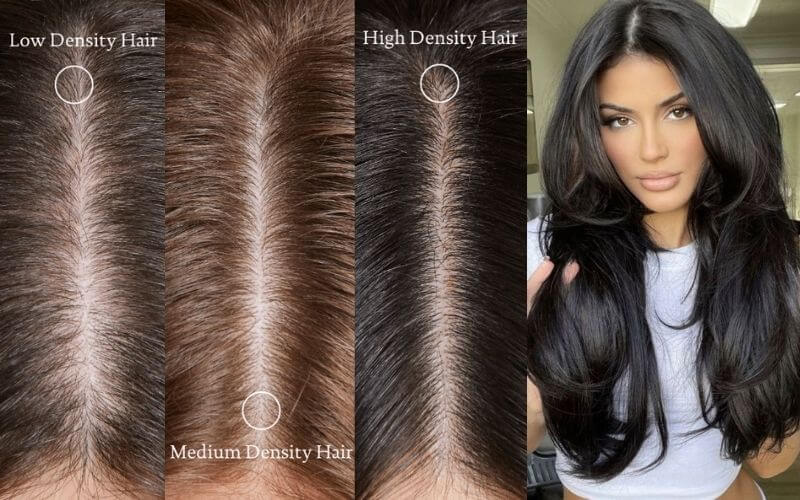
Lyn Hair – A Vietnamese hair wig vendor offers various hair wig density customization following customer requirements including low density wigs. Be sure to check product descriptions and reviews to ensure you’re selecting a wig with the density you desire.
7.2. How to check hair density?
To check your hair density, start by parting your hair and looking at your scalp. If you can easily see a lot of your scalp, your hair density is likely low. If the scalp is less visible, it’s probably high-density. You can also take a small section of hair and gently pull it apart. If the strands are packed closely together, it indicates high density. Additionally, try the “two-finger test”: place two fingers on your scalp and pull a section of hair through. If you can fit more than two fingers comfortably, your hair is high-density. If only one finger fits, it’s low-density.
7.4. Is 180 or 250 density better?

A 250% density wig offers a fuller, more voluminous look than an 180% density wig, as it has more hair strands per square inch, resulting in a thicker, heavier feel. While 180% density is already considered full and provides a natural yet voluminous look, the 250% density wig gives a more dramatic and luxurious appearance, making it perfect for long or straight hairstyles where extra fullness is desired.
𝑭𝒐𝒓 𝒎𝒐𝒓𝒆 𝒊𝒏𝒇𝒐𝒓𝒎𝒂𝒕𝒊𝒐𝒏, 𝒄𝒐𝒏𝒕𝒂𝒄𝒕:
Whatsapp: +84.936.085.069
Follow us on Instagram: @lyn.hair_official
Website: lynhair.com

